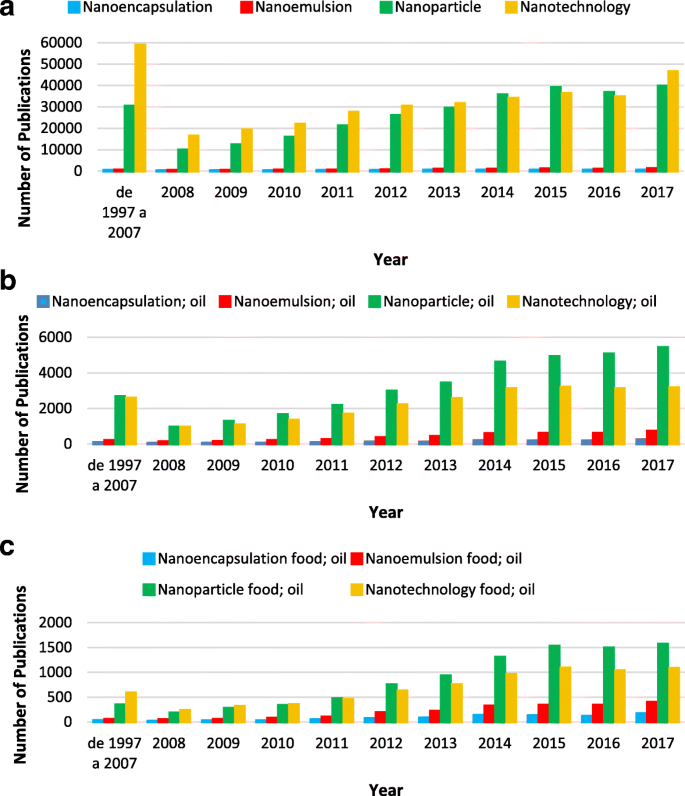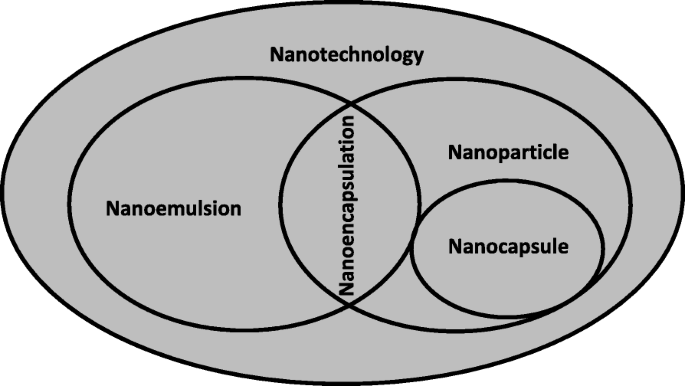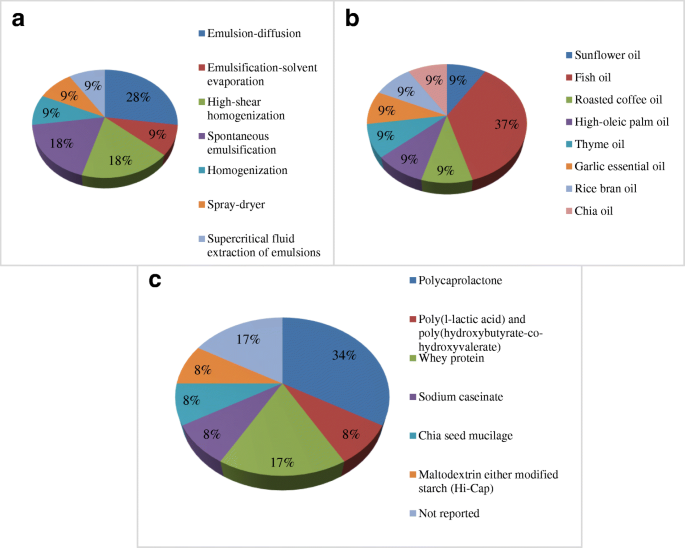オイルナノカプセル化:開発、応用、食品市場への組み込み
要約
油は人間の栄養において非常に重要な物質です。ただし、それらは酸素、熱、湿気、および光に敏感です。近年、油の改質技術への関心が高まっています。オイルの特性を変更し、オイルを適切な用途にする方法がますます研究されています。ナノテクノロジーは、従来の食品科学と食品産業に革命をもたらす可能性のある最も有望な研究技術の1つになりました。油のナノカプセル化は、安定性を高め、ナノカプセル化された化合物のバイオアベイラビリティを改善するための有望な代替手段となる可能性があります。石油ナノカプセル化の発生は、特に食品業界で急速に増加しています。さまざまな油に適用される従来のナノカプセル化技術は、油のナノ粒子合成に直接影響を及ぼし、ゼータ電位、サイズ、多分散度指数などのパラメーターに影響を与えます。これらの特性により、さまざまな業界でのオイルの使用が制限される可能性があります。このレビューでは、食品業界における油のナノカプセル化を要約し、安定した油のナノカプセルを得るためのさまざまな技術の技術、利点、および制限に焦点を当てています。また、技術革新の重要な機会と利点を示し、特許出願によるこの技術の保護を分析します。過去20年間で、石油ナノカプセル化は食品業界で大幅に成長しました。ナノカプセル化された油製品は現在食品業界では見られませんが、食品科学分野には、油のナノカプセル化が市場のトレンドになると報告している記事が数多くあります。それでも、特許出願で実証されているように、さまざまな領域でナノカプセル化オイルを塗布できます。
はじめに
油は人間の栄養に重要な役割を果たしています。カロリーを提供するだけでなく、A、D、E、Kなどの脂溶性ビタミンの媒体としても機能します。オイルは、リノール酸、リノレン酸、アラキドン酸などの必須脂肪酸の供給源でもあり、食品の嗜好性に。最も表現力のある油成分はトリグリセリドであり、これらのトリグリセリドの物理的特性は、現在の脂肪酸の構造と分布に依存します[1,2,3,4]。
石油生産の約90%は、種子の加工に由来する植物由来であり、人間が消費することを目的としています。業界では、特にケーキ、ビスケット、パン、マーガリン、乳製品などの製品の配合や揚げ物に使用するための食品用途において、幅広い天然資源からの油に対する市場の需要が高まっています。他のアプリケーションの中でも[5、6]。
石油生産の残りの10%は、動物飼料の生産に向けられており、殺菌剤、石鹸、洗剤、石鹸、生分解性軟化剤、化粧品、バイオディーゼルの製造原料など、いくつかの産業プロセスで使用されます[5]。
>食用油の栄養的および経済的重要性を考慮すると、近年、これらの油の改質技術への関心が高まっています。油の特性を変更し、特定の用途に適したものにするために、改質技術がますます研究されています。研究者たちは、食品の品質と安全性を向上させるためのさまざまな技術を発見しました。食品産業へのナノテクノロジーの関与は、より優れた熱安定性、より優れた溶解性、および新規でより高いレベルの経口バイオアベイラビリティを備えた食品の生産につながりました[7]。
ナノテクノロジーは、食品の貯蔵寿命を延ばし、汚染物質の追跡と追跡方法を改善し、食品貯蔵戦略を改善し、健康補助食品や抗菌剤の食品への組み込みを促進することにより、食品科学の分野にプラスの影響を与えることが示唆されています。したがって、ナノテクノロジーは確かに食品科学に大きく貢献しています[7]。
ナノテクノロジーは、従来の食品科学と食品産業に革命を起こす最も有望な技術の1つになりました。ナノテクノロジーを利用した加工と包装は、食品システムにおけるナノテクノロジーの重要性を証明しています。異なる調製技術は、異なる物理的特性を持つナノ粒子を生成する可能性があります。したがって、これらの粒子は食品に使用できます[8、9]。
カプセル化は、生物活性脂肪滴がクラストによって回収されるか、不均一または均一なマトリックスに封入されて、1000nm未満のサイズのナノスケール[10]の小さなカプセル[3]を作成するプロセスです。ナノメートルは1メートルの10億分の1です[ 11];カプセル化には多くの有用な特性があります[3]。ゴネットらによると。 [12]、カプセル化は、天然/天然油の特性を長期にわたって維持するための潜在的なアプローチです。ナノまたはマイクロカプセル化で開発された古典的なシステムは、リザーバーまたは母殺し粒子に基づいています。
その利点に加えて、ナノカプセル化は、カプセル化された活性物質のバイオアベイラビリティを強化し、機能の処理中に見られる化学的効果[13、14]、酵素効果、物理的不安定性などの自然および処理効果からそれらを保護することを特徴とします、栄養補助食品[13]、医薬品、化粧品[3]製品[10]。カプセル化は、有効成分の送達や貯蔵寿命の制御など、生物学的効率を改善する手段でもあり、副作用の発生を防ぐことができます[12]。
これらのシステムが酸素、フリーラジカル、または紫外線(UV)[12、15]などの酸化促進元素に対する物理化学的障壁を構成し、対象となる食品の範囲を広げる可能性があることを考慮すると、油のカプセル化は酸化反応を防止または遅らせる可能性があります濃縮の目的。たとえば、生物活性油のカプセル化は、油の放出の変更、環境酸化反応からの保護、物理的安定性の向上、揮発性の低下、毒性の低下、生物活性の向上、および患者のコンプライアンスと利便性の向上[3]。具体的には、食品業界では、このテクノロジーにより、風味の保持、酸化防止、貯蔵寿命、色、異臭などの加工食品の品質が向上します。食品の保管期間を延長します。成分を環境から保護し、保存中のフレーバーの損失を減らし、生物活性物質の放出を制御します[16]。
カプセル化には多くの手法が適用されます。一般に、生物活性剤のカプセル化には3つの方法が使用されます。(a)カプセル化された薬剤の周囲にバリア構造が作成されます。 (b)汚染された物質は立ち入りを拒否されます。 (c)カプセル化されたエージェントは、望ましくない損害から保護するために配置されています[17]。
多くの場合、ナノカプセル化は、油相と水相によって形成されるシステムであるナノエマルジョンの生成から始まります。ナノカプセル化は、ほとんどの場合、乳化剤を使用して乳化されます。さらに、ナノエマルジョンは小さな液滴サイズと高い表面積で形成されます[18]。このような特性により、優れた物理的安定性や高いバイオアベイラビリティなど、従来のエマルジョンに比べて潜在的な利点が得られます[19]。オイルナノエマルジョンおよびオイルナノカプセル化を得るために研究されたいくつかの技術には、ナノ沈殿、噴霧乾燥、イオンゲル化、予め形成されたポリマーの界面堆積、エマルジョン拡散、乳化-溶媒蒸発、脂質の使用、高剪断均質化(マイクロ流動化)、自発乳化が含まれる、およびナノ構造脂質担体(NLC)。
この研究の目的は、食品業界における石油カプセル化の潜在的および現在の用途を調査し、革新の主な利点と機会を示し、食品市場における現在の製品や特許出願を含む将来の課題も検討することです。新しいナノカプセル化された石油製品と特許出願は、さまざまな産業分野での石油の使用に有望です。さらに、マイクロおよびナノカプセル化は、(a)コア材料の外部環境への蒸発または移動速度の低下を促進する可能性があります。 (b)外部環境への反応性の低下による劣化からの炉心材料の保護。 (c)時間の経過とともにゆっくりと、または特定の時間に、コア材料の放出速度を制御する。 (d)取り扱いを容易にするために、元の材料の物理的特性を変更する。 (e)コア材料の望ましくないフレーバーまたは味のマスキング。 (f)そうでなければ互いに反応するであろう混合物成分の分離。 (g)ホスト材料に均一に分散させるために少量しか必要とされない場合のコア材料の希釈[17]。
コロイド状ナノ粒子の一般的なナノカプセル化
ナノ粒子やその他のナノ構造の合成は、光学的、機械的、化学的特性などの特性が、バルク材料とはまったく異なるサイズ、幾何学的構造、およびコンポーネントに強く依存するため、近年大きな注目を集めています。 20、21]。
ナノ粒子はコロイド粒子です。光学的透明性を達成するのに十分に小さい粒子を有する2つの最も一般的なタイプのコロイド送達システムは、マイクロエマルジョンおよびナノエマルジョンである。どちらのシステムにも小さな粒子が含まれています( d <200 nm)。マイクロエマルジョンに対するナノエマルジョンの主な利点の1つは、それらを形成するために必要な界面活性剤がかなり少ないことです。食品グレードのナノエマルジョンは、高エネルギー法(高圧均質化や超音波処理など)または低エネルギー法(転相温度、自発乳化、エマルジョン転相など)によって形成できます[22]。
コロイド粒子は、金属[20]、生物医学[23]、医療[24]、センサー[25]、光学[25]、香料、飲料、忌避剤、香料、化粧品など、さまざまな提案に対応して製造できます。薬効成分[26]、食品[22]に使用され、さまざまな目的でエッセンシャルオイル(EO)に使用されます[27、28]。
エマルジョンを含むコロイド送達システムは、多価不飽和脂肪酸(PUFA)を水性環境に組み込んで、システムの酸化安定性を向上させるように設計できます。これらのエマルジョンベースのデリバリーシステムのほとんどは、光の波長と同様の寸法の粒子を含んでいるため、光を強く散乱させ、高い濁度または不透明度をもたらします。特定の用途では、透明なデリバリーシステムを使用すると、一部の強化水、清涼飲料、ドレッシングなどの光学的に透明な食品や飲料製品に組み込むことができるので有利です[22]。
ソフトドリンクに関しては、Ziani etal。 [29]レモンオイル、非イオン性界面活性剤(Tween 80)、およびバッファー(pH 2.6)を含むコロイド分散液を形成しました。この研究は、食品および飲料にフレーバーオイルやその他の機能性脂質をカプセル化するための食品グレードのコロイド送達システムの合理的な設計に役立つ情報を提供します。
固体脂質ナノ粒子(SLN)は、マイクロカプセルと前述のナノスケールコロイド担体システムの両方の欠陥を克服する能力があるため、製薬および食品業界でますます注目を集めています。 SLNは、最新世代のナノスケールカプセル化システムであり、腸壁を通過する活性化合物の高い透過性に関連する高い溶解速度の親液体ナノエマルジョンまたはマイクロエマルジョンから得られる利点と、物理的およびカプセル化された化合物の化学的安定性と取り扱いの容易さ[30]。
固体粒子マトリックスを有する脂質ナノ粒子は、液体脂質(油)を固体脂質で置き換えることにより、O / W(油/水)エマルジョンから誘導されます。これらの脂質は通常、毒性の低い生理的脂質(生体適合性)です[3]。 SLNは、室温および体温で固体である脂質で構成されています。 SLNの主な利点は、高いカプセル化効率、大規模生産の可能性、固体マトリックスによる制御放出プロファイルの柔軟性、および標的臓器に到達する高い能力です。ただし、SLNは結晶化する可能性があるため、オイルを取り込むためのスペースが非常に狭くなるため、積載量が少なくなります[31]。脂質ナノ粒子の直径は、50nmから1μmの範囲である可能性があります[3]。 SLNはカプセル化の負荷が低く、保管中に爆発する可能性があります[31]。
米ぬか油ナノカプセルは、壁材料としてポリ(ε-カプロラクトン)(PCL)を使用して合成され、マウスのUVB放射線誘発皮膚損傷に対する保護効果を評価しました。著者らは、米ぬかナノカプセル(200 nm、ゼータ電位- 9 mVおよび<0.2)の低い多分散性指数(PDI)は、UVB照射によって誘発される浮腫の60%を抑制しました[32]。
Oehlke etal。 [33]フェルラ酸(FA)とトコフェロール(Toc)でSLNを調製しました。最大2.8mg g -1 を含むさまざまな製剤 FAまたはTocは、室温で少なくとも15週間保存しても安定していました。著者らは、これらのSLNは、活性化合物の段階的な放出が有益である可能性がある食品添加物として適していると結論付けました。
石油ナノカプセル化の傾向
過去20年間の多くの出版物には、ナノカプセル化、ナノエマルジョン、ナノ粒子、ナノテクノロジーの4つの用語が含まれています(図1)。ただし、2000年代以前は、1990年代後半に開始された石油および食品用途の研究に関するこれらの4つの用語を含む記事は、調査対象の出版物の2%未満であり、このトピックはナノテクノロジーの小さなセクターになっています(図1)。

次のキーワードを使用した、Scopusデータベース内のナノカプセル化、ナノエマルジョン、ナノ粒子、およびナノテクノロジーの出版物の年間数: a ナノカプセル化、ナノエマルジョン、ナノ粒子、およびナノテクノロジー。 b ナノカプセル化とオイル、ナノエマルジョンとオイル、ナノ粒子とオイル、ナノテクノロジーとオイル。および c ナノカプセル化と食品と油、ナノエマルジョンと食品と油、ナノ粒子と食品と油、ナノテクノロジーと食品と油
ナノテクノロジーという用語は、より一般的な用語として多くの出版物で使用されていました(図2)。これらの用語と「油」を組み合わせて使用すると(図1b)、「ナノ粒子」という用語を含む出版物の増加が見られます。 「ナノエマルジョン」と「オイル」に関する出版物の数は、2010年以降、一般的な分野でも食品に関連する分野でも大幅に増加しています(図1b)。

油に一般的に使用されるナノカプセル化の定義のスキーム
「ナノ粒子」と「ナノテクノロジー」に関する出版物ははるかに多くありますが(図1a)、カプセル化は、物質のマイクロ粒子とナノ粒子へのパッケージングを説明するために使用される最も適切な用語であり、1つの物質が関与するプロセスとして定義されます。 「壁材」と呼ばれる別の製品内の「活性剤」として[34,35,36]。
オイルナノカプセル化に関するほとんどの出版物は、「ナノカプセル化」[2、37、38、39、40、41、42]または「ナノエマルジョン」[10、43、44、45、46、47、48]という用語を使用しています。 「ナノカプセル」という用語を使用する著者もいれば[49,50,51]、「ナノ粒子」を使用する著者もいます[35,41]。ただし、どちらの用語も元々は「ナノカプセル化」(図2)を意味し、最も広い意味で使用されており、ナノカプセルとナノ粒子形成の両方を含みます[52]。
「ナノ粒子」という用語は、ナノスフェアとナノカプセルの両方の総称です[17]。ナノカプセルは、液体核を備えた高分子膜を備えており、その中で、活性化合物は、高分子膜に囲まれた内部液体コアからなる空洞に閉じ込められています(コアシェル構造は親油性または親水性である可能性があります)[3、17]。一方、ナノスフェアは、生物活性堆肥が拡散し、捕捉され、カプセル化され、ポリマーマトリックスに化学的に連鎖または吸着される固体コロイドフラグメントとして定義できます。ポリマーマトリックスは多孔質または固体マトリックスを形成し、コアはコポリマー構造に依存して固体材料に変わる可能性があります[3、53]。ナノ粒子は通常、免疫学的相互作用を減らし、粒子表面の化学基の分子相互作用(ファンデルワールス、水素結合、または疎水性相互作用)を減らすのに役立つ非イオン性界面活性剤でコーティングされています。ナノ粒子の細胞内取り込みは、他のカプセル化されたシステムよりも高くなっています。適用された方法論によれば、ナノカプセルは、高分子内膜への保持された活物質へのビヒクルとして作用し得る。これらのシステムから放出されたオイルは、脱着、拡散、または侵食によってナノ粒子から標的組織に輸送される可能性があります[3]。
ナノエマルジョンは、油相と水相によって形成されるシステムであるナノカプセル化の始まりであり、乳化剤を使用してこれらの相を乳化します。さらに、ナノエマルジョンは、小さな液滴サイズと高い表面積で形成されます[10、18、37、54]。このような特性により、優れた物理的安定性や高いバイオアベイラビリティなど、従来のエマルジョンに比べて潜在的な利点が得られます[10、19]。
最初のナノテクノロジーの定義は、1959年に有名な物理学者のリチャードファインマンが彼の講演で議論しました底にはたくさんの部屋があります 、彼は直接原子操作による合成の可能性を説明しました。 「ナノテクノロジー」は、1974年に谷口紀男によって最初に使用されました。ナノテクノロジーは1980年代に分野として登場し、それ以降、この分野での科学出版物や認知度が高まっています。この分野の研究は2000年代に強化され(図1)、科学的、政治的、商業的な注目も高まり、論争と進歩の両方につながりました。さらに、ナノスケール技術の進歩に基づく製品の商品化が始まりました[55]。
ナノテクノロジーは、広範囲の材料、プロセス、およびアプリケーションをカバーし、化学、物理、生物学、電子、および工学の科学を網羅する学際的な分野です。これは、ほぼ1〜100 nmのナノスケール範囲での物質の製造、特性評価、および実験に焦点を当てています。成長表面積に関連する最小粒子サイズは、独特で斬新な特性を示し、技術的用途に大きな可能性を生み出します[55,56,57]。
ナノテクノロジーは、熱および貯蔵安定性、水溶性および生物活性物質の戦略を前進させ、食品使用の生物学的利用能を高め、味、食感、工業プロセス、着色強度などの食品のマクロスケール特性を強化することができます[58]。主要な食品会社は、独自の研究部門を使用して、機能性食品にナノテクノロジーを適用するための戦略を設計しています[59]。
石油ナノカプセル化アプリケーションの現状
食品分野の成長は、図1b、cで、「食品」と「油」および「ナノカプセル化」、「ナノエマルジョン」、「ナノ粒子」、または「ナノテクノロジー」というキーワードを要約に含む出版物の総数として定量化されています。;情報は発行年の関数として表示されます。図1の傾向が示すように、食品ナノテクノロジー分野の成長のほとんどは、90年代後半の多数のナノテクノロジー研究と、ナノ粒子プロセスに適した食品グレードの添加物の成長により、2010年以降に発生しました。業界の石油ナノカプセル化アプリケーションを表1にまとめています。
現在、食品業界のナノテクノロジー製品は10億米ドルの価値に達し(主に健康促進製品、包装技術、ドラフト用のナノ粒子コーティングで構成されています)、今後10年間で200億米ドル以上増加する可能性があります。 。多くのレビューは、食品ナノテクノロジー分野をリードしてきた研究グループと民間および公的機関の優れた要約を示しています[11、13、60]。
多くのレビュー[11、13、55、60、61]は、食品ナノテクノロジーへの投資と一次生産のためのナノテクノロジーの新たな応用について論じていますが、油をカプセル化された材料と見なす場合の油ナノカプセル化に対処するレビューはありません。さらに、ナノテクノロジーアプリケーションに関する多くのレビューがあり[13、53、55、61、62、63、64、65、66、67、68]、それらのほとんどは食品アプリケーションにおけるナノテクノロジーに焦点を当てています[13、52、55、 61,62,63,64,65,66,67,68]。
食品業界では、マイクロカプセル化プロセスはさまざまな理由で使用できます。これは、Desai and Park [4]によって次のように要約されています。(a)コア材料は、外部環境への応答を減らすことによって劣化から保護されます。 (b)主要物質の外部環境への蒸発または移動速度が低下する。 (c)元の材料の物理的特性が変更されて取り扱いが容易になっている。 (d)コア材料の放出は、時間の経過または特定の時間にゆっくりと発生するように調整されています。 (e)コア材料の不要なフレーバーまたは味がマスクされている。 (f)キーパー材料の均等な分散が達成されます。 (g)そうでなければ互いに反応するであろう混合物成分が分離される。これらのアプリケーションは、オイルのナノカプセル化にも適しています。 Ricaurte etal。 [10]およびCampoetal。 [37]異なる目的で高オレイン酸パーム油(HOPO)とチアシード油を研究しました。最初の研究は、HOPOから得られたナノエマルジョンの最も好ましいマイクロ流動化、形成、および貯蔵条件を見つけることを目的とし、2番目の研究は、脂質酸化から油を保護し、溶解性と安定性を改善する代替案を約束しました(表1)。
Cushen etal。 [9]食品のマイクロカプセル化が十分に確立されているという上記の主張を確認します。マイクロカプセル化された魚油は、機能的な健康上の利点のためにパンに適用されています。マイクロカプセル化プロセスは魚油の不快な味を覆い隠し、このパンはすでに市場で実現可能です。食品産業における化合物のナノカプセル化と添加は、技術の論理的な進歩です[2、68]。さらに、脂肪、油、脂質ベースの食品の主な劣化プロセスである酸化反応は、栄養価と感覚の質の低下をもたらし、油のナノカプセル化は、ナノカプセル化プロセス中に形成される保護バリアの形成を通じて酸化の減少を促進します。前に述べた[2]。
彼らのレビューでは、ウォーカー等。 [47]は、オメガ3脂肪酸のカプセル化、セキュリティ、および放出にナノエマルジョンを使用する可能性を強調しました。これらのキャリーシステムは、食品業界でこれらの生理活性脂質を含む飲料に使用したり、食品を強化したりすることができます。また、サプリメントや製薬業界で、機能性オメガ-3脂肪酸組成物の生物活性を高めるために使用することもできます。
Sozer and Kokini [67]は、食品および食品包装業界でのナノテクノロジーの使用を簡素化しました。食品の利点の種類には、酸化に対する保護が含まれます。カプセル化された成分の制御放出(水分またはpH);変装をテストします。ナノカプセル化された栄養物質、ビタミン、およびフレーバーの送達。食品システムにおける病原体の検出;食品安全;と品質分析。一部の食品包装用途には、改善された包装(ガスおよび湿気バリア、引張強度)が含まれていました。アクティブパッケージング、ナノ添加剤、インテリジェントパッケージング、栄養補助食品の配送、および制御放出による貯蔵寿命の延長。セルフクリーニングパッケージの抗菌効果;輸送中の製品状態監視。食品包装への応用は、食品の安全性と品質を高めることができるため、非常に有望であると考えられています。これらのアプリケーションには、食品と相互作用できるインテリジェントパッケージが含まれます。ただし、食品業界での油のナノカプセル化アプリケーションでは、通常、魚油が使用されます。ナノカプセル化の目的は、主に食品強化のための脂質酸化から油を保護することです[34、38、40]。
ご覧のとおり、魚油はマイクロカプセル化とナノカプセル化の両方で最も使用されている油です。それは不飽和およびPUFAの源です。人間は脂肪酸の大部分を生産することができます。それにもかかわらず、人間の栄養に不可欠なオメガ-6(n-6)およびオメガ-3(n-3)脂肪酸は、人間の有機体によって合成することはできません。したがって、人間は食物からそれらを取得する必要があります。 PUFAを含む植物油(食用油)の摂取は、心血管障害や神経障害などの慢性疾患の発生率が低く、癌の発生率が低下することに関連しています[3、69]。
生物活性油は通常、その栄養特性のために使用されますが、それらの使用に関する主な問題の1つは、保管中の活性成分の損失です[70]。これは、生物活性油にPUFAや、酸素、水分、熱、光に敏感な他の物質(キサントフィル、ステロール、カロテノイド、モノテルペン、フラボノールなど)が含まれているために発生します[71]。酸化油で形成される生成物には、多数のフリーラジカル種、脂質ヒドロペルオキシドなどの一次酸化生成物、および炭化水素、アルデヒド、エポキシド、およびケトンなどの二次酸化生成物が含まれます。これらの製品のいくつかは、生体組織に悪影響を与える可能性があります[72]。この酸化により、油の特性と栄養価が失われ、不快な味と臭いが生じます[3]。
これらの油に含まれる他の活性化合物は、抗酸化作用、抗炎症作用、抗ウイルス作用、抗菌作用、抗癌作用、および/または組織再生作用を示す可能性があります[73]。油中のポリフェノールとトコフェロールは、重要な抗酸化作用を示します。したがって、酸化防止剤の特性と組成は、オイルの種類によって異なります。したがって、オリーブ、ヒマワリ、アルガン、グレープシードオイルには抗酸化化合物が多く含まれています[72]。さらに、ステロール、カロテノイド、キサントフィル、フラボノール、モノテルペンなどの不安定な化合物の存在も、油の栄養価と健康特性に貢献します[3]。
さらに、EOは生物学的に活性な物質の混合物で構成される一般的な植物製品であり、潜在的に生物活性のある化合物と新しい分子テンプレートを提供します[74、75]。 EOは、抗真菌、抗菌、抗酸化、抗炎症、抗ウイルス、および抗癌活性を持つ揮発性の二次代謝産物で構成されています[76]。 EOの効率は、その化学組成、遺伝子型、環境および農業条件に依存します[77]。これらのオイルの例としては、タイム、ラベンダー、ペパーミント、シナモン、ティーツリー、ローズマリー、ユーカリ、レモングラスオイルなどがあります。これらのオイルは抗菌特性を示すことが示されていますが、酸化に対して非常に脆弱です[15、27、78]。
EOは、食品媒介性病原体の増殖の抑制に使用するのに適していると考えられる天然の生物活性分子として分類されます。ただし、EOを食品に直接組み込むことは、一部のEO成分の揮発性が高く、水性製剤へのEOの組み込みが困難であり、食品の官能特性が大幅に変化する可能性があるため、技術的な課題があります。抗菌作用を示す成分の中で、オレガノ、カルバクロール、チモール、γ-テルピネンが食品に使用されています。
いくつかのエッセンシャルオイルは、肉、鶏肉、フルーツジュースなどの食品の微生物的、感覚的、化学的品質を改善するために使用されてきました[28、79、80、81]。 Ghaderi-Ghahfarokhi etal。 [28]ナノカプセル化されたタイムエッセンシャルオイルは、ビーフバーガーに使用されました。彼らは、カプセル化プロセスがタイムエッセンシャルオイルの貯蔵寿命を改善し、貯蔵開始時の活性化合物の気化を最小限に抑えることを観察しました。さらに、保管中のタイムエッセンシャルオイルの徐放は、冷蔵保管が終了するまで、オイルの抗酸化および抗菌活性を維持または増加させる可能性があります。さらに、ハンバーガーの赤みとオキシミオグロビン含有量は対照と比較して正の変化があり、フリータイムのエッセンシャルオイルはビーフバーガーの受容性と感覚の質を改善しました。
食品の安全性と品質を改善するために天然の防腐剤として食品中のエッセンシャルオイルを使用し、有害な合成食品防腐剤に取って代わった研究があります[49、82]。 Herculano etal。 [82]ユーカリをカプセル化し、リステリア菌に対するロードされたナノ粒子の抗菌作用を測定しました および Salmonella enteritidis バクテリア。著者らは、ナノカプセル化された油が S に対して増強された活性を示したため、ナノ粒子殺菌作用がグラム陰性菌よりもグラム陽性菌に対してより効果的であることを観察しました。 。 enteritidis ;これらのナノ粒子は、自然保存のための食品に使用できます。
構造がアラビアガムに似ているカシューガム(CG)は、 Anacardium occidentale の浸出液から抽出されたヘテロ多糖です。 、ブラジル北東部で一般的な木。カシューガムは水と相互作用することができるため、安定剤、乳化剤、接着剤として機能し、より高価なアラビアガムの優れた代替品となる可能性があります。 CGはHerculanoらによって使用されました。 [82] Eucalyptus staigeriana をカプセル化する エッセンシャルオイル(ESO)、および製剤からのカプセルの直径(nm)とゼータ電位(mV)は、それぞれF1:153.80±8.20と-24.50±0.45でした。 F2:27.70±3.42; − 14.47±1.42、およびF3:432.67±41.47; −10.45±0.21。これらの製剤はF1:CG:ESO =2:1で構成されていました。 ESO:Tween 80 =2:1; F2:CG:ESO =4:1; ESO:Tween 80 =2:1; F3:CG:ESO =2:1; ESO:Tween 80 =1:1。 F1とF2のサンプルは単峰性の分布を示しましたが、F3は二峰性の分布(ナノ粒子と微粒子)を示しました。
Nanoencapsulation Methods Applied in Different Oils
In this review, 11 studies that used nanoencapsulated oils in the food industry were analyzed [10, 16, 35, 37, 38, 83,84,85,86,87], and 1 figure, Fig. 3 was made that describes the technologies, nanoencapsulated oils, and wall materials used. Generally, there are many methodologies for the production of nanocapsules containing oils, such as emulsion-diffusion [16, 38, 85], emulsification-solvent evaporation [83], high-shear emulsification [10, 87], spontaneous emulsification [84, 88], homogenization [37], spray drying [35], and the emulsion supercritical fluid extraction process [86] (Fig. 3a). In general, the techniques are similar, with some particular similarities between each of them.

Proposal and techniques (a ), employed oils (b ), and wall materials (c ) of some studies using oil nanoencapsulation in food
In emulsion-diffusion, an emulsion is produced after a dilution causes the deposition of a polymer around the droplets, whereas in emulsification-solvent evaporation, an emulsion is formed with a polymer solution and an aqueous phase. The solvent is evaporated at the end of both techniques. High-shear homogenization, or microfluidization, is a kind of high-energy emulsification which uses microfluidizers to create mechanical shear. This equipment works by dividing a liquid jet into two parts. Every part passes through a narrow opening. Normally, emulsions with a diameter greater than 1 μm are first formed by other methods, after which their sizes are then reduced in a microfluidizer [3].
Spontaneous emulsification, or low-energy emulsification or self-emulsification, is a process which depends on different variables:interfacial and bulk viscosity, interfacial tension, phase transition region, and surfactant structure and concentration because the emulsion is formed spontaneously as a result of the low interfacial tension from high surfactant levels. In the homogenization (nonspecific name) technique, the emulsion is composed of an organic phase, which has a surfactant, organic solvent and oil, and of an aqueous phase, which is composed of water and a polymer. The organic phase is added dropwise to an aqueous solution. Then, the solvent is removed by a vacuum process [37].
The spray dryer technique is based on dissolving or dispersing the active ingredient in a biopolymer solution. Then, the dispersion is atomized in a heated air chamber that rapidly removes the solvent and produces a dried particle consisting of the active ingredient embedded in a porous wall material [31]. The supercritical fluid extraction of emulsions (SFEE) technique is based on the use of supercritical carbon dioxide (CO2 ) to rapidly extract the organic solvent from an oil-in-water emulsion, in which a bioactive compound and its coating polymer have been previously dissolved. By removing the solvent, both compounds precipitate, generating a suspension of particles in water [86].
In addition to that in oil microencapsulation, the oil usually used in nanoencapsulation is fish oil [16, 35, 38, 86] (Fig. 3b). However, sunflower oil [85], roasted coffee oil [83], HOPO [10], thyme oil [87], garlic essential oil [84], rice bran oil [88], and chia oil [37] are also used (Fig. 3b).
Oil nanocapsules have been produced with the application of different wall materials (Fig. 3c), depending on the usage and kind of oil to be nanoencapsulated. Unlike oil microencapsulation, oil nanoencapsulation does not usually involve wall material mixtures. Usually, the wall material is used alone because the particles formed must have a size of 1000 nm, and, as there is a larger contact surface, the fewer the compounds in the nanocapsule formulation the better the interaction is among the compounds, ultimately favoring the particle size.
The wall materials most used in the techniques are biodegradable polymers. Some usual wall materials used in oil nanoencapsulation are polycaprolactone [16, 38, 86, 88], whey protein [10, 35], sodium caseinate [87], chia seed mucilage [37], maltodextrin, or modified starch [35] (Fig. 3c). Some authors did not report the wall material used in their study [88], probably because of the spontaneous emulsification technique that was employed.
Wall material is chosen according to the size of the required nanoparticles, aqueous solubility and stability, and other factors. Among polymers, most of the wall material utilized is poly(ε-caprolactone) (PCL). PCL is a polymer obtained through the ring-opening polymerization of the cyclic monomer Ɛ-caprolactone utilizing cationic or anionic, coordination, or the radical catalysts mechanism. This polymer is semicrystalline, and its crystallinity is directly associated with its molecular weight. It is soluble in inorganic solvents and has a good blend compatibility that provides a transformation of chemical properties, such as solubility and porosity, and it presents a low melting point (59–64 °C). Furthermore, PCL is a synthetic, biocompatible, and fully biodegradable polymer that has a semi crystalline nature (glass transition temperature of 213 K). It is approved for drug delivery by the Food and Drug Administration (FDA). Due to its slow degradation, PCL is ideally suited for long-term delivery or when a targeted delivery to the intestinal tract is intended. PCL has a high hydrophobicity, high in vitro stability, and low cost [87]. Usually, PCL is utilized in the emulsion-diffusion method and supercritical fluid extraction of emulsions, especially for fish oil encapsulation [16, 86].
Whey protein may also be applied to nanoencapsulate bioactive compounds such as oils because of its functional characteristics, such as its surface activity, gelation, shielding, and protective properties, e.g., biocompatibility and biodegradability [58]. Ricaurte et al. [10] applied HOPO and obtained nanocapsules with whey protein from microfluidization, confirming that this methodology was able to create stable nanocapsules with a diameter of 163 nm.
After synthesis, the basic characterization of the oil nanoparticles is determined by important parameters, such as the size, polydispersity index (PDI), and zeta potential. The size and size dispersion of nanocapsules are important because of their ability to transform the physicochemical and pharmaceutical behaviors of the encapsulated ingredients [58].
Nanoparticle size, also named the mean diameter or z-average, may be established by several methods, such via laser diffraction (LD) and a Coulter counter; however, the most applied technique is dynamic light scattering (DLS) [58, 89], which allows the description of particle size distribution and destabilization phenomena. Nevertheless, it is not very precise when used with large size differences; it is noted that particles larger than 1 μm will be subject to gravitational movement in addition to Brownian motion, which makes this technique suitable for the characterization of particles only < 1 μm.
For nanoencapsulated oils, the diameter size is usually between 100 and 1000 nm [10, 16, 35, 37, 38, 83, 85, 87] or less than 100 nm [84, 86,87,88]. Diameters larger than 1000 nm were found by Ricaurte et al. [10]; those authors reported diameters between 163 and 2268 nm using the microfluidization method and whey protein as a wall material in the nanoencapsulation of HOPO.
Size dispersion is indicated as the PDI, an index that describes the particles uniformity in suspension; PDI values between 0.1 and 0.25 [10, 38, 87, 88] indicate a small size distribution, and PDI values higher than 0.5 indicate a broad distribution [50]. Although some authors, such as Choi et al. [16], Campo et al. [37], and Jafari et al. [35], did not report PDI, it is a good parameter for characterizing nanoparticles when used with particle size and zeta potential. Campo et al. [37] did not perform PDI analysis, but they found a bimodal figure in one of the diameter size results, suggesting the presence of nano and microparticles; if PDI was performed, the values would likely be greater than 0.25.
Zeta potential is a physical characteristic that is shown by particles in suspension, macromolecules, or substance surfaces; it corresponds to the nanoparticle’s electrical potential, as influenced by the nanocapsule ingredients and the medium in which they are distributed. This parameter is widely applied to indicate suspension stability in colloidal dispersions, where zeta potential values higher than 30 mV and lower than − 30 mV promote high stability and prevent particles aggregation [90]. The majority of the studies examined here obtained results between these values (30 mV and − 30 mV) [10, 37, 38, 84, 85]. Some authors, such as Choi et al. [16], Freiberger et al. [83], Bernardi et al. [88], Jafari et al. [35], and Pietro and Calvo [86], did not report the zeta potential.
For nanoencapsulated oils, the zeta potential is usually variable because of wall material characteristics. Campo et al. [37] obtained a zeta potential of − 11.58 ± 1.87 mV for encapsulated chia oil with chia seed mucilage as wall material. Nanoparticles of anionic gums, such as chia seed polysaccharide and cashew gum, can present negative zeta potential due to the presence of carboxylic acids groups in the carboxylate form (-COO-) that generates negative charges [82].
Another important analysis for the characterization of nanoparticles is Fourier-transform infrared spectroscopy (FTIR), which is a technique used to obtain an infrared spectrum of the absorption or emission of a solid, liquid or gas. An FTIR spectrometer simultaneously collects high spectral resolution data over a wide spectral range. This provides a significant advantage over a dispersive spectrometer, which measures intensity over a narrow wavelength range. FTIR is a less intuitive way to obtain the same information. Usually, oil nanoparticles are used in the transmittance mode, operating with wavelengths between 400 and 500 and 4000 cm −1 and a resolution of 4 cm −1 [37, 84, 91].
Based on FTIR analysis, it is possible to physically perceive the interactions that take place between the nanoparticle components; for example, the FTIR results of nanoencapsulated garlic essential oil showed the characteristic Tween 80 (the emulsifier used) peaks. This phenomenon could be related to coverage in the garlic oil nanoemulsion spectrum due to the stretching vibration of the extracted garlic bands. The band at 1325–1450 cm −1 showed the presence of S=O, and the band at 1675–1600 cm −1 showed a -C-C=C symmetric stretch, both of which are present in garlic EO compounds [84].
Incorporation of Nanoencapsulated Oils into the Food Market and Patent Application
According to the House of Lords [92], food currently contains structures at the micro and nanoscale. Fruit juice is composed by plant material that was built from nanoscale ingredients, while Bailey’s Irish Cream contained nanoemulsions with an average droplet size of 190 nm. Margarine had water droplets smaller than 10 μm across, with even smaller fat crystals interspersed in them. The naturally occurring nanomaterials found in food ranged from particles smaller than 100 nm found in drinks such as tea, beer, and coffee to protein structures of approximately 300 nm found in eggs or soy to larger oil particles of approximately 800 nm found in substances such as milk. All fresh and processed food was structured at the nanoscale, and consequently, the body evolved over time to deal with nanoscaled materials.
Few studies have been performed on the incorporation of nanotechnology incorporation into trade [65]. Furthermore, no products that contained oil nanoencapsulation were found in the market. However, there are numerous oil microencapsulation products that can be found in trade, and there is an article that highlights this information [93]. This finding may be attributed to the fact that, in general, nanotechnology is relatively new, and it is a relatively complex technology to employ. However, it is possible to notice some similarities between the methods used for the micro and nanoencapsulation of oils. In addition, the regulation gap in nanotechnology raises some uncertainties about the use of this technology in the market.
Concerning nanotechnology regulation, there are a number of ongoing EU research projects aimed at addressing all aspects of nanosafety, including toxicology, ecotoxicology, risk assessment, exposure assessment, mechanisms of interaction, and standardization. Examples of ongoing EU projects include the NanoLyse project, which is dedicated to the development of analytical tools for the detection and characterization of engineered nanoparticles in food, and the NanoReTox project, which seeks to address the human health and environmental implications of exposure to engineered nanoparticles [94]. However, regulatory institutions such as the Environmental Protection Agency (EPA) and the Food and Drug Administration (FDA) in the USA or the Health and Consumer Protection Directorate of the European Commission have started addressing the potential risks posed by nanoparticles. So far, neither engineered nanoparticles nor the products and materials that contain them are subject to any special regulation regarding production, handling, or labeling.
Although there is no specific nanoparticle regulation, there are some food industry patent documents deposited in different countries. WO2018029626, a patent application from Argentina, focused on chia oil with an edible nanoemulsion. It described a chia oil nanoemulsion comprising between 10 and 20% of chia oil (Salvia hispanica L. ), between 2 and 5% of polysorbate, between 0.5 and 5% of at least one emulsifier other than the polysorbate, between 0.05 and 0.2% of at least one antioxidant, and water. Formulations of edible chia oil nanoemulsions used in transparent drinks and desserts, such as juices and jellies, were disclosed [95]. A patent application from the Republic of Korea, KR20160005182, focused on cinnamon oil nanoemulsions to inhibit the development and increase of dangerous food microorganisms. Furthermore, this invention could not only be used for food additives, food packaging materials, preservatives, etc. but also be utilized in the pharmaceutical and cosmetic industries [96]. A mustard oil nanoemulsion application patent from China, CN103315956, was prepared to alleviate the pungent smell of mustard oil to avoid volatilization, and the mustard oil may be used for bacterial resistance in food and drugs [97]. Wang Weichun Feng Wei submitted an application patent from China, CN103750050, describing a palm oil nanoemulsion that solved the problems of high grease costs, low absorption rates, low oil content in the existing prepared palm oil nanoemulsions, large granularity, poor stability, long production periods, high equipment investments, and high production costs in existing young animal feeds. The palm oil nanoemulsion was prepared by mixing an emulsifier with palm oil, cutting and emulsifying the mixture, and ultrasonically performing cell breaking in the mixture. The process was simple, the entire reaction process was easily controlled, the entire process production period was short, the equipment investment and production costs were low, the oil content of the produced nanoemulsion was high, the distribution granularity was small, the stability was good, and the digestion by livestock increased [98].
There is a growing trend of oil nanoencapsulation patent applications, indicating that many innovations have been made and attesting to the technology the global market.
結論
Nanoencapsulation is well-established for oil preservation. It offers a plethora of advantages, including the effective protection of the encapsulated oil against degradation, the possibility of accurate control of the oil release, easy administration, and avoidance of the evaporation of the volatile components. Moreover, nanoencapsulation may be achieved by a variety of techniques. Technique selection will depend on the physicochemical characteristics of the active compounds, the processing conditions, particle size and density necessary to incorporate the oil properly into the final product, the mechanism of release, and the cost constraints. Although there currently are not many oil nanoencapsulation products in the food market, there is no doubt that if boosted by recent remarkable scientific advances, new approaches in oil nanoencapsulation will soon be considered in the application of oils in food additives and nutritional supplements, and patents application will continue to increase.
略語
- CG:
-
Cashew gum
- CO 2 :
-
二酸化炭素
- DHA:
-
Docosahexaenoic acid
- DLS:
-
動的光散乱
- EOs:
-
Essential oils
- EPA:
-
Eicosapentaenoic acid
- ESO:
-
Eucalyptus staigeriana essential oil
- FA:
-
Ferulic acid
- FDA:
-
Food and Drug Administration
- FTIR:
-
フーリエ変換赤外分光法
- HOPO:
-
High-oleic palm oil
- LD:
-
Laser diffraction
- n-3:
-
Omega-3 fatty acids
- n-6:
-
Omega-6 fatty acids
- PCL:
-
Poly(ε-caprolactone)
- PDI:
-
Polydispersity index
- PUFA:
-
Polyunsaturated fatty acids
- SFEE:
-
Supercritical fluid extraction of emulsions
- SLN:
-
固体脂質ナノ粒子
- Toc:
-
Tocopherol
- US EPA:
-
United States Environmental Protection Agency
- UV:
-
Ultraviolet radiation
ナノマテリアル



